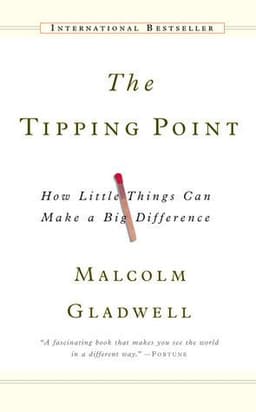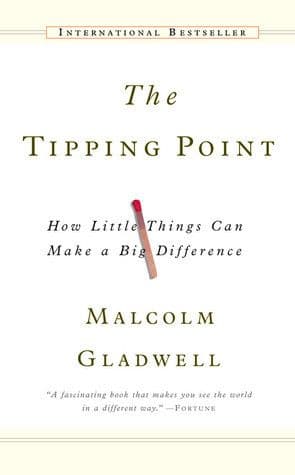
Revenge of the Tipping Point Book Summary
Overstories, Superspreaders, and the Rise of Social Engineering
Book by Malcolm Gladwell
Summary
In "Revenge of the Tipping Point," Malcolm Gladwell argues that social epidemics are not random or mysterious, but follow predictable rules and can be shaped by the power of influential individuals, the contagious narratives that frame our world, and the delicate balance of group dynamics.
Sign in to rate
Average Rating: 4.5
Three Puzzles
Epidemics Are Not Wild And Unruly
Gladwell argues that contrary to popular belief, epidemics and social contagions are not mysterious, wild phenomena that happen at random. They follow rules and have boundaries. They are subject to "overstories" - the narratives and ideas circulating in a culture. Epidemics can change drastically when they reach a tipping point. And they are driven by a small number of influential people who can be identified.
Section: 1, Chapter: 1
The Law Of The Few Drives The L.A. Bank Robbery Epidemic
In the 1980s and 90s, Los Angeles suffered an epidemic of bank robberies, driven by a small number of "super-robbers" like the Yankee Bandit, Casper and C-Dog. These criminals robbed prolifically and influenced copycats, demonstrating the "Law of the Few" - that social epidemics are driven by the extraordinary actions of a small number of people. The context also enabled the epidemic, with the number of bank branches in the U.S. tripling from the 1970s to 1990s.
Section: 1, Chapter: 1
Small-Area Variation In Medical Practice
In the 1970s, researcher John Wennberg discovered huge variations in medical practices between similar towns in Vermont. In Stowe, 70% of kids had their tonsils removed by age 15, versus only 20% in nearby Waterbury. Wennberg found that these differences stemmed from varying doctor attitudes in each town, not patient preferences. He termed this "small-area variation" - how local doctor culture shapes medical practices as much as hard science.
Section: 1, Chapter: 1
Small-Area Variation Beyond Medicine
"Small-area variation has subsequently become something of an obsession for medical researchers. Books are written about it. Scholars spend their days studying it. But what's fascinating is how the same inexplicable patterns of variation turn up outside the world of medical care."
Section: 1, Chapter: 1
Waldorf Schools Create Vaccine Skepticism
Across California, Waldorf schools - a chain of alternative private schools - consistently have the lowest vaccination rates in their areas, often under 50%. Researcher Elisa Sobo found this stemmed not from parents choosing Waldorf because they were already vaccine skeptics, but from parents absorbing vaccine skepticism over time from the Waldorf school culture and community. Demonstrating how certain environments can shift beliefs and behavior.
Section: 1, Chapter: 1
The Miami Overstory Shapes Philip Esformes
Healthcare mogul Philip Esformes ran a massive Medicare fraud scheme out of his Florida nursing homes. At his sentencing, Rabbi Sholom Lipskar argued Esformes was corrupted by moving from Chicago to Miami, saying he "lost himself" and "went down a wrong path" after arriving in Florida. Suggesting that the "overstory" - the attitudes and narratives - of Miami's culture shaped Esformes' descent into crime.
Section: 1, Chapter: 2
Three Seismic Events Transformed Miami In 1980
Historian Nicholas Griffin argues three events in 1980 transformed Miami's institutions and culture:
- An influx of drug money, especially from cocaine trafficking
- The Mariel Boatlift of Cuban refugees which changed demographics overnight
- The McDuffie Riots which led to an exodus of white residents
This "perfect storm" undermined faith in institutions and established different norms around corruption and fraud.
Section: 1, Chapter: 2
The Perils of a Monoculture
The affluent town of Poplar Grove prided itself on being the perfect place to raise successful kids. But it created a "monoculture" where nearly all students were pressured to fit the same narrow mold of achievement in academics, sports, and college admissions.
Diversity is the natural state of healthy systems. Monocultures only emerge when something upsets the normal order, sanding down differences. While Poplar Grove parents saw their town's uniformity as a feature, it left the community brittle and vulnerable, like cheetahs whose lack of genetic diversity made them susceptible to infectious disease.
As a rash of suicides devastated the town, residents realized too late the cost of engineering a world with no room for kids to be different. Epidemics love monocultures.
Section: 1, Chapter: 3
Cheetahs Have Little Genetic Diversity
Geneticist Stephen O'Brien discovered that cheetahs have almost no genetic variation between individuals - they are like natural clones. He believes a "genetic bottleneck" occurred around 12,000 years ago, where the cheetah population may have dwindled to a single breeding female. Subsequent inbreeding meant genetic uniformity. This leaves them vulnerable - to disease and environmental change. O'Brien demonstrated this by successfully transplanting skin grafts between unrelated cheetahs, something only possible for identical twins.
Section: 1, Chapter: 3
The Social Engineers
At 30% Minorities, White Flight Occurs
In the post-WW2 era, as black Americans increasingly moved into white urban neighborhoods, sociologists noticed a disturbing pattern. Once the minority population hit around 30%, most of the white population would flee within a few years - "white flight." This "tipping point" held true across different cities and eras. Civil rights activist Saul Alinsky argued that many whites would tolerate a small, stable black population, but not true integration. Tipping points can be used for exclusion as much as inclusion.
Section: 2, Chapter: 4
Rosabeth Kanter's Radical Idea
In the 1970s, when Rosabeth Kanter was asked to investigate why a sales force's newly hired women were struggling, she had a courageous insight - being the "only one" in a group is a major disadvantage. Kanter called this phenomenon "tokenism."
Kanter realized that women were held back not because of their individual abilities, but because vastly outnumbered in a male-dominated workplace. As "tokens," women faced exaggerated scrutiny, pressure to represent all women, and exclusion from the real team.
Her radical solution was that companies should ensure women make up at least 35-40% of a group - what she called the "critical mass." Only when women's representation reached this "magic third" would they be liberated from the disadvantages of tokenism and able to thrive.
Section: 2, Chapter: 4
Critical Mass Of Minorities Eliminates Achievement Gaps
Research on elementary school test scores reveals a striking pattern. In classrooms with few minority students, a persistent achievement gap exists, with black students scoring significantly lower than white peers. But in classrooms where black students make up over 25% of the class, the achievement gap disappears entirely - with black students performing just as well as whites. A "critical mass" of minority students seems to eliminate the harms of tokenism and marginalization on performance.
Section: 2, Chapter: 4
Rugby Team Used By Harvard To Control Demographics
In 2013, Harvard University created a varsity women's rugby team, despite already having the most sports teams of any college. This let them recruit dozens of additional student-athletes. Admissions data shows that athletes are accepted at dramatically higher rates than non-athletes, even with significantly lower grades and test scores.
Rugby recruits skew heavily white and come from posh prep schools worldwide. Gladwell argues this is how Harvard maintains its desired "group proportions" and slyly practices affirmative action for affluent white applicants.
Section: 2, Chapter: 5
A Brief History of Jewish Quotas
In the 1920s, Harvard president Abbott Lawrence Lowell was disturbed by the growing numbers of Jewish students earning admission on academic merit. He proposed capping Jewish enrollment at 15% - high enough to avoid charges of overt discrimination, but safely below the "tipping point" where Jews might undermine Harvard's WASP cultural majority.
To achieve this quota without explicitly barring Jews, Lowell pushed for evaluating applicants on subjective traits like "character" and "leadership," as well as legacy status, geographic diversity, and athletic talent. Lowell's vision of favoring "well-rounded" applicants over pure scholastic achievers remains the template for elite college admissions today.
As one historian put it, Lowell "bequeathed to us the peculiar admissions process that we now take for granted." His policies for social engineering became so embedded, we forgot they were engineered at all.
Section: 2, Chapter: 5
The Perils of Secretive Social Engineering
"Social engineering takes on a very different face, however, when the engineers go about their business in secret. There is far too much of this second, hidden kind of manipulation going on. If we are to protect the integrity of our institutions, we need to be made aware of the games being played below the surface."
Section: 2, Chapter: 5
A Single Infection At Biogen Sparked Global Spread
In February 2020, executives from biotech company Biogen held a conference in a Boston hotel. A single infected attendee, likely from Europe, sparked a massive outbreak. Genetic sequencing shows that roughly 100 people caught COVID at the event, then rapidly spread it worldwide as they flew home - to 29 U.S. states and at least 4 continents. The strain from this "superspreader event", dubbed C2416T, likely infected hundreds of thousands globally. Demonstrating how quickly one infection in the right environment can fuel an epidemic.
Section: 2, Chapter: 6
20% Of Infections May Cause 80% Of Spread
Growing evidence suggests that COVID and other infectious diseases follow the "Pareto principle" - that roughly 20% of cases may cause 80% of transmission. So-called "superspreaders" seem to be significantly more contagious than the average infected person, sparking large clusters. This may be due to:
- Biological factors like higher viral load
- Behavioral factors like interacting with many people
- Number and type of contacts
- Environment and setting
This highly skewed distribution means that finding and containing superspreaders early is key to controlling outbreaks.
Section: 2, Chapter: 6
The Overstory
How a TV Miniseries Made the Holocaust Speakable
In 1978, NBC aired the miniseries Holocaust, which followed a fictional German Jewish family through the horrors of the Nazi genocide. Though panned by many critics, the series was a national phenomenon, viewed by 120 million Americans - half the country.
Holocaust marked a crucial turning point in how Americans understood and talked about the Jewish tragedy. Before the series, the term "Holocaust" was not widely used. Most people had only a vague sense of what occurred in the concentration camps. After Holocaust aired, "Holocaust" became the universal term for the Nazi massacre of the Jews.
Section: 3, Chapter: 7
"It's Not the Media Pushing This Button to Get That Effect"
Scholar Larry Gross argues that television's impact comes not from overt messaging but from the assumptions baked into entertainment:
"It's not the media pushing this button to get that effect. It's the media creating the cultural consciousness about how the world works... and what the rules are."
Gross found that heavy TV viewership narrowed the gap between liberals and conservatives on hot-button social issues. Exposure to the same set of stories week after week, year after year "brings them together."
Gross says, "I always like to quote this line from a Scottish writer, Andrew Fletcher, 'If I can write the songs of a nation, I don't care who writes their laws.'"
Section: 3, Chapter: 7
The Long Arc of Changing Attitudes Toward Gay Rights
In the early 1980s, when Evan Wolfson wrote his law school thesis making the case for same-sex marriage, the idea was so far outside the mainstream that he couldn't find a professor willing to serve as his advisor. Popular culture, exemplified by the 1969 bestseller Everything You Always Wanted to Know About Sex* (*But Were Afraid to Ask), portrayed gay men as promiscuous, maladjusted, and incapable of stable relationships.
The AIDS crisis further stigmatized gay life in the public imagination. In 2004, a majority of Americans supported amending the U.S. Constitution to prohibit same-sex marriage.
Yet by 2012, the tide had dramatically turned, with a rapid cascade of states legalizing same-sex marriage and polls registering solid majority support. Once considered an impossibility, gay marriage became the norm in a historical blink of an eye. Understanding this dizzying transformation requires looking beyond politics to the realm of popular culture.
Section: 3, Chapter: 8
The Rules of Representing Gay Life on TV
Scholar Bonnie Dow identified persistent patterns in how gay characters were portrayed on American television from the 1970s through the 1990s:
- Gay characters are only peripheral in stories ostensibly about them. They are foils designed to teach the straight characters tolerance.
- Being gay is presented as the overwhelming problem in a gay character's life, often leading to misery and death.
- Gay characters appear in isolation, never in community with other gay people.
These tropes reinforced a dominant tragic narrative of homosexuality incompatible with fulfillment or social integration. Hit 1990s shows like Doing Time on Maple Drive centered a gay character's struggle, but still portrayed him as an anomaly, a Problem to be Solved. Such shows did little to undermine the assumption that heterosexuality was the necessary bedrock of family life.
Section: 3, Chapter: 8
"Will & Grace" Subverts Sitcom Tropes To Normalize Gay Characters
The hit 1998 sitcom "Will & Grace" featured gay lawyer Will and his straight female friend Grace as leads, with gay character Jack as a flamboyant sidekick. Though criticized by some as stereotypical, the show subverted common TV tropes by:
- Making gay characters central to the story
- Not treating gayness as a problem to be solved
- Showing gay characters with gay friends and community
While Will remained celibate, the show portrayed him as a successful, funny, relatable person who just happened to be gay - a radical step for 90s network TV.
Section: 3, Chapter: 8
Misleading "Passive Voice" Obscures Agency In Opioid Crisis
When discussing culpability for the opioid epidemic, pharma execs and consultants use the passive voice to deflect responsibility. McKinsey consultants write about "pills that were abused" and Purdue Pharma's reps say their products "have been associated with abuse." But this language masks the active role these companies played in causing the crisis through deceptive marketing, influencing doctors, and downplaying risks. To clearly assess the roots of such crises, Gladwell argues we must restore agency by asking "Who took what actions?" Not just "What happened?"
Section: 3, Chapter: 9
Aggressive Marketing To "Weak Link" Docs Fuels Opioid Epidemic
Section: , Chapter:
Small Number Of "Super-Prescribers" Write Huge Share Of Opioid Rxs
The opioid epidemic was fueled by a tiny minority of doctors who prescribed huge volumes of the drugs, responding to pharma company marketing. During the height of the crisis, analysis shows that:
- The top 1% of prescribers wrote 49% of opioid prescriptions
- Some wrote over 1,000 times more Rxs than the average doctor
These "super-prescribers" - numbering just a few thousand nationwide - enabled widespread misuse, while most doctors prescribed cautiously. Gladwell argues any successful response to such crises requires identifying and intervening with the most extreme "superspreaders."
Section: 3, Chapter: 9
Reformulating Oxycontin to Prevent Abuse Backfired
In 2010, Purdue reformulated Oxycontin to make it harder to abuse by crushing and snorting. Many in public health thought this would deter opioid abuse. Instead, it led many users to switch to more dangerous alternatives like heroin and fentanyl. By 2020, overdoses from these illegal opioids were over 4X higher than prescription opioids.
In hindsight, Gladwell argues, we would have been better off without the reformulation, keeping the Oxy crisis contained to a "manageable" problem. But once the reformulation pushed users into the black market, it spiraled beyond control. The change in "group proportions" proved disastrous, like removing a mildly sick fish from an aquarium and introducing a far deadlier contagion in its place.
Section: 3, Chapter: 9
We Have The Power To Shape And Contain Epidemics
Though we often feel powerless in the face of contagious epidemics, Gladwell argues this book shows we do have agency:
- We can craft positive "overstories" that influence behavior for the better, like Madden did with opioids in some states, or Will & Grace did with attitudes toward gays
- We can identify the "superspreaders" - the Oxycontin doctors or MeToo abusers - and remove their influence
- We can be conscious of "group proportions" and work to integrate groups in ways that shape more positive outcomes
The intricate dynamics of social epidemics are not, in the end, beyond our understanding or control. We already have many of the tools. We must consciously choose to use them to build healthier communities.
Section: 3, Chapter: 9
Our Power to Understand and Shape Epidemics
"Epidemics have rules. They have boundaries. They are subject to overstories - and we are the ones who create overstories. They change in size and shape when they reach a tipping point - and it is possible to know when and where those tipping points are. They are driven by a number of people, and those people can be identified. The tools necessary to control an epidemic are sitting on the table, right in front of us. We can let the unscrupulous take them. Or we can pick them up ourselves, and use them to build a better world."
Section: 3, Chapter: 9
Related Content


The Tipping Point Book Summary
Malcolm Gladwell
The Tipping Point reveals the hidden forces that cause social epidemics - from fashion trends to crime waves - to spread like viruses, and shows how to start and control positive epidemics of our own.
The Tipping Point reveals the hidden forces that cause social epidemics - from fashion trends to crime waves - to spread like viruses, and shows how to start and control positive epidemics of our own.
Psychology
Personal Development
Sociology
Economics


On The Edge Book Summary
Nate Silver
"On the Edge" takes readers on a captivating journey through the high-stakes world of poker, sports betting, and risk-taking, revealing the counterintuitive strategies and mental habits that allow gamblers and daredevils to thrive in the face of daunting odds.
"On the Edge" takes readers on a captivating journey through the high-stakes world of poker, sports betting, and risk-taking, revealing the counterintuitive strategies and mental habits that allow gamblers and daredevils to thrive in the face of daunting odds.
Economics
Decision Making
Prediction
Game Theory


Nexus Book Summary
Yuval Noah Harari
In "Nexus: A Brief History of Information Networks from the Stone Age to AI," Yuval Noah Harari explores how the flow and organization of information has shaped human history, arguing that the rise of artificial intelligence could lead to either unprecedented human cooperation or the dominance of digital dictatorships.
In "Nexus: A Brief History of Information Networks from the Stone Age to AI," Yuval Noah Harari explores how the flow and organization of information has shaped human history, arguing that the rise of artificial intelligence could lead to either unprecedented human cooperation or the dominance of digital dictatorships.
History
Technology
Artificial Intelligence

